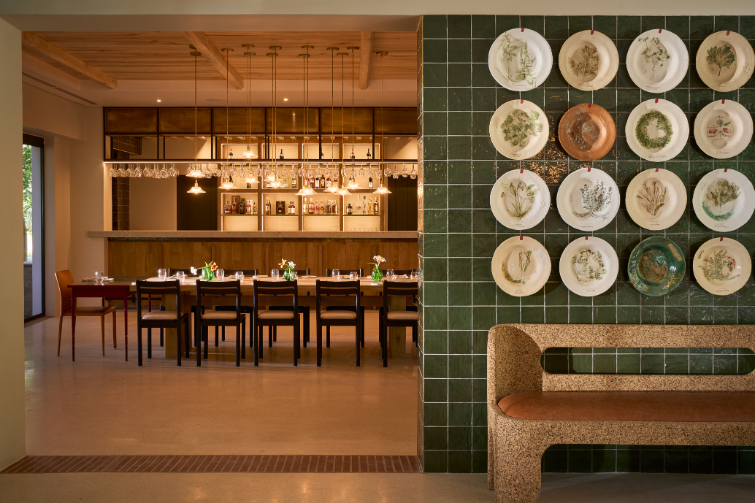Nico Grobler had always dreamed of owning a patch of Elgin to make Chardonnay and Pinot Noir in the best Burgundian tradition. This dream became a reality when stepped onto his very own Elgin property in 2021 – the brand home of La Brune.
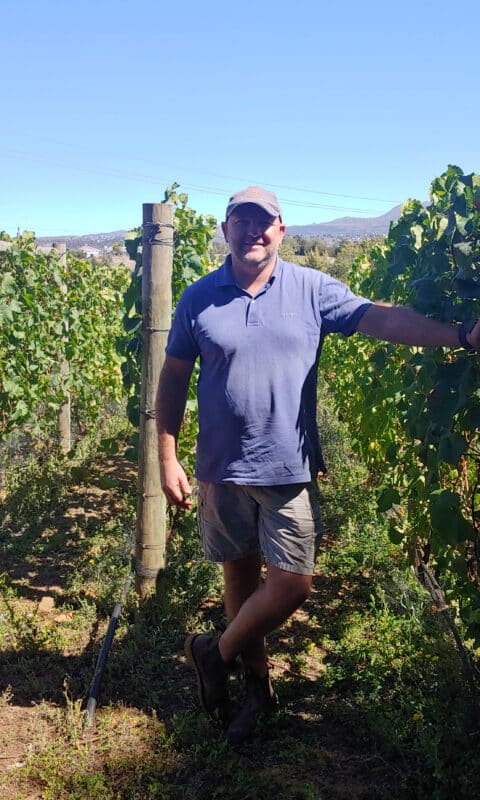
Nico Grobler, founder and winemaker at La Brune.
The small French town of Mercurey has special significance for winemaker Nico Grobler, not only because of the friendships he forged there as a young winemaker in 2007, but also because of the lasting impressions its wine had left on him. It set off a lifelong love affair with Burgundian Pinot Noir and Chardonnay, a relationship that might have made his wife Christelle jealous if she hadn’t been the first to suggest they christen their fledgling new brand La Brune – the brunette.
Fourteen years later, Nico finds himself in Elgin tending La Brune’s high-density Pinot Noir, with more hectares being prepared for his Chardonnay. He’s aware of the privilege he was afforded through a network of propitious connections, but also thankful for mavericks like Eben Sadie and Adi Badenhorst for sowing the seeds to inspire a whole new generation of winemakers who didn’t enjoy the privilege of an estate or wine heritage. “They succeeded through sheer winemaking, having a clear vision and chasing a dream,” Nico says. “That story is meaningful and resonates because it can be achieved through honest, hard work.”
High density
It all began with a block of Pinot Noir planted on Reine Dalton’s apple farm in Elgin. High-density vineyards are a common sight in Europe but somewhat unusual here in South Africa, yet it’s a key ingredient of La Brune’s wine. “It comes down to two fundamental principles,” he says. “The most basic consideration for any vine is light intensity – how it’s concentrated and how it can reach the bunches.”
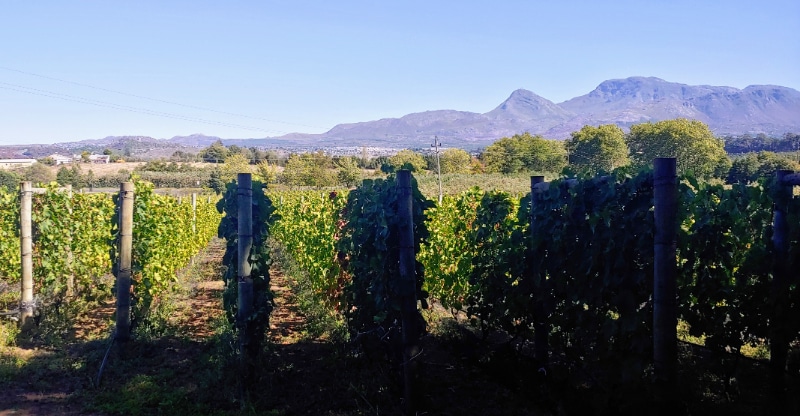
La Brune’s High-density Pinot Noir.
“Everything that happens in the grapes comes from light intensity, and because you have broken sunlight in high density vineyards it means you have to plant with the sun. This is especially valuable for Pinot Noir, which is sensitive to direct sun and benefits from the more even exposure afforded by broken sunlight for more even ripening.”
The other consideration is vigour. According to Nico, the average Stellenbosch vineyard is planted at 3300 vines per hectare, spaced 2.5 m by 1.2 m, and averages around 26 bunches per vine for premium production. “The vines just keep growing. There’s enough water, sun and little competition, which means a lot of permanent wood and vegetative growth, while consuming a lot of resources.”
By comparison, Nico’s Pinot Noir was planted at 10000 vines per hectare in 2011. The rootstock remains slim, but it only has to nourish about fourteen shoots and eight bunches per vine. “That means the vineyard has enough resources for this year’s growth while allowing it to build up reserves for the following year. It’s labour-intensive, since we don’t have the machinery readily available, and the initial capital expenditure is huge.”
Nico was only able to justify it by taking a long-term view for his brand, aiming to enter the market at a price point where the wine would be able to pay for the grapes and justify the cost. “I wouldn’t do it any other way.” The end result is a situation where there’s such a demand for the wine that the price will make sense.
And once the vineyard is paid off, it will keep delivering quality grapes for at least another fifty to sixty years, especially since Nico keeps up a strict renewal programme and removes virus-infected vines when they appear. “I tend the vineyard like a garden,” Nico explains.
Truly Elgin
Ever faithful to his Burgundian brunette, Nico only makes Chardonnay and Pinot Noir. Nico’s friend, Bruno Lorenzon of Domaine Lorenzon in Mercurey (Côte Chalonnaise Burgundy), who set him on this winemaking journey, provides the custom-made barrels for his wines.
Elgin is the coolest wine producing area in the country, a full 300 Winkler index points below Ceres which the next in line. “In Elgin we have wind and cool air that gets captured in the valley, as well as high humidity, altitude above sea level, and cloud cover even in during warm growing season, when the warm air in the valley rises to meet the cool air coming from the ocean to create cloud cover. The climate is a combination of all these elements, and remains cool even if one of them isn’t present.”
Nico’s overarching goal is to give a true expression of Elgin’s unique soils and growing conditions. “I want people to be able to pick up Elgin in a blind tasting; that’s the one thing nobody else has.”
Chardonnay
La Brune’s Chardonnay currently comes from a single block planted with three different clones. “The Dijon clone 96 which was developed to provide more body and structure to Chardonnay,” Nico says. “That means it has a little bit more fruit, but being planted on sandstone it shows a little more elegance and perfume in the wine and a little more width than the other clones. The one thing that connects them is that the wine ‘ends on the sandstone’, with a beautiful minerality.”
To this, Nico adds a fermentation of the popular Burgundy clone 548. It’s a low-yielding clone that’s not considered suitable for high-production environments, but enhances the wine’s quality. “Clone 548 is a mineral clone that’s perfect for sandstone, providing a natural minerality. In a great Chardonnay, you’re not thinking about peach or apricot or fruit, but about all those subtle flavours in perfect balance. Nothing is obvious. It’s about the soil, the vineyard, the producer, the philosophy, the area.”
The wines are matured in barrel for 12 months – a full season. Nico believes it helps to leave some lees from the of the previous vintage in the barrel when adding the next vintage. “I can smell it when I put the wine in the barrels; it’s like the wine knows it’s among family.”
The wines will keep developing in the bottle, gaining texture and complexity. But Nico insists great wines are always in balance, whether in tank, barrel or bottle. “There should be a straight line from the vineyard to the bottle; it shouldn’t have to fight battles along the way,” Nico says. “If the wine starts out in balance, it will give you greater complexity.”
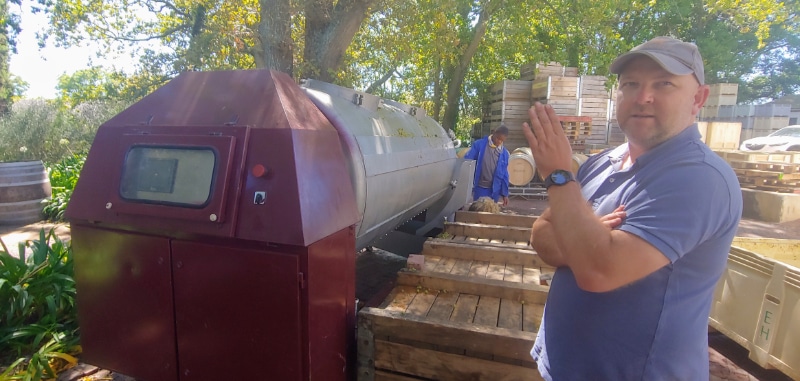
Nico with his trusty old 2.7 tonne pneumatic press. This model used to be manufactured locally.
Pinot Noir
For his Pinot Noir, the goal is an elegant, linear wine. “There’s a reason Pinot Noir is one of the most sought-after wines in the world. Ninety percent of Romanée-Conti is never drunk, only traded. No other cultivar can do that.”
La Brune’s tanks have been especially constructed for the Pinot Noir. About 40% of the tank is dedicated to cooling, which allows for effective cold-soaking. The tanks are heated as soon as the juice is ready for fermentation.
Since as much as half the grapes are whole-bunch fermented for a slower extraction, Nico manages the cap as they do it in Burgundy: by climbing into the tanks and lifting out the whole bunches manually. It’s hot, strenuous work, but softer and more effective than pump-overs or punch-downs.
“Clone 113 is the ‘Cabernet Franc’ of Pinot Noir,” Nico says. “It gives you that earthy character with chalky tannins, and length rather than fruit, like the old Burgundy style. This clone comprises about a 30% of the final blend.”
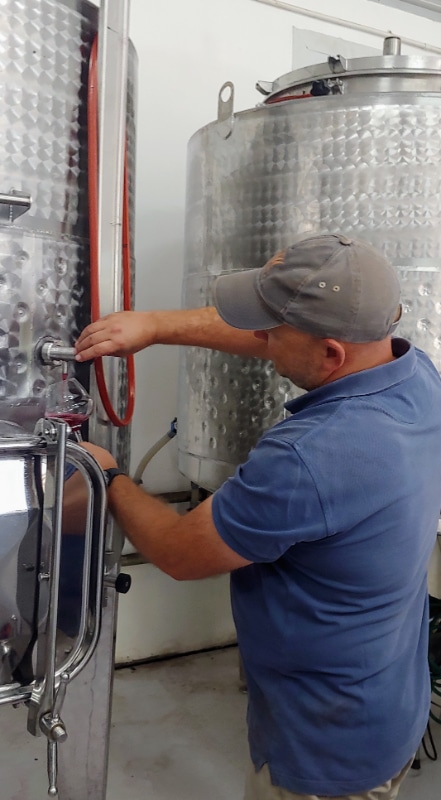
These fermentation tanks are custom-made to match the height of the winemaker’s shoulders so that he can keep his head above the fumes during extraction.
Clone 459 is a newer Pinot Noir used to contribute colour and fruit, which means using less whole bunches to keep its fruitiness. It will show most while the wine is still young. The backbone of La Brune’s Pinot Noir comes from clone 115, yielding lots of colour, fruit and structure, but with sufficient length and elegance. “You really have to understand what each clone contributes, otherwise the result will make no sense.”
Nico only started approaching critics in 2022, waiting for his style to mature and stand on its own feet. Last year saw Tim Atkin award La Brune its first 95, while Jamie Goode and Neal Martin have also endorsed the wine. But Nico considers these accolades as benchmarks rather than achievements to pursue. It gives him a seat at the same table where Premier Cru Burgundy wines are being served. “People don’t buy La Brune because there’s a sticker on it, but because it’s exactly what they want.”


